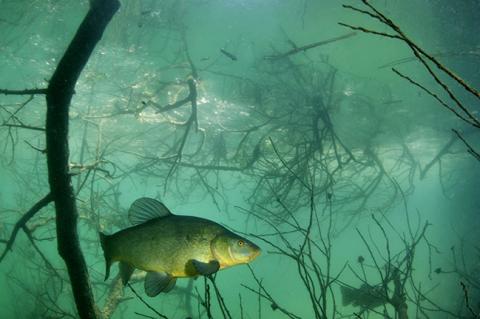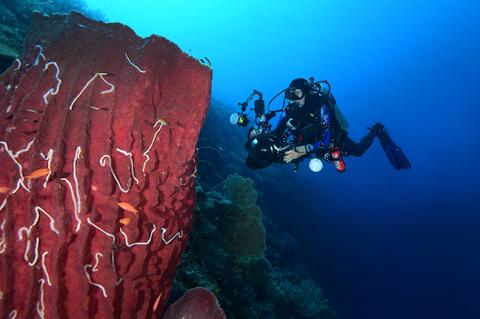X-Ray Mag #94
Main features in this issue include:
Isla Mujeres: Swimming with Whale Sharks in Mexico
Every year, as the summer heat descends on the Yucatan peninsula, an amazing phenomenon takes place in the waters to the northeast of the small holiday island of Isla Mujeres. Local fishermen call it the Afuera (Mexican for “outside”), in reference to those deeper waters offshore from the tip of the Yucatan where, come July and August, the largest known gathering of whale sharks (Rhincodon typus) takes place.
Long considered as solitary giants roaming the open oceans, aggregations of whale sharks seemed quite rare and, prior to the discovery of the Afuera, a large gathering was thought to comprise 15 to 20 whale sharks.
Jens Umbach Portfolio
German artist and illustrator Jens Umbach creates surreal paintings of marine life floating in pastoral landscapes and deep-sea creatures in otherworldly seascapes with underwater moons. With a new children’s book soon to be published, X-Ray Mag interviewed the artist to learn more about what inspires his fantastical and imaginative imagery.
"We know more about the dark side of the moon than we know about the depths of the oceans, and so it is a perfect hunting ground for one’s imagination."
—Jens Umbach"
Malta's Deep-Water Wrecks
Ranging from calm shore dives for beginner divers to technical diving on elusive, unmarked wreck sites, which can only be found via depth sounder—diving in Malta has it all. Just beyond Malta’s dramatic underwater landscapes of strange rock formations, chimneys and caves, visitors can discover Malta’s intriguing and piquant past.
Currently rated as the world’s tenth smallest and fifth most densely populated country, Malta is the biggest of the three islands of the Maltese Archipelago, which also includes Gozo and Comino islands.
New Ideas on Narcosis
Researchers have raised some eye-opening thoughts on nitrogen narcosis, showing that it is something that most divers THINK they understand but few actually do.
This issue’s column is adapted from a chapter in my book Scuba Physiological: Think you know all about Scuba Medicine?
River Treasures: Freshwater Biodiversity in Italy
When considering underwater photography, we usually think about images of wonderful coral reefs, colourful fish, clear waters and undersea landscapes. In fact, 70 percent of our planet is covered by water on its surface, and, even though 97 percent of this is saltwater, the remaining three percent is freshwater in rivers, streams, lakes, ponds, marshes and groundwater.
Moreover, these often turbid and turbulent freshwater bodies host a huge variety of species, many of them as big and colourful as their marine counterparts.
Sidemount Tanks: Getting Them to Behave Themselves & Sit Where They Should
One of the least mysterious things about sidemount diving is how to rig a set of steel primary cylinders so they hang at diver’s sides as they are supposed to, rather than hanging pendulum-like below them. However, some still struggle to get it anywhere close to right. Perhaps this article will help.
There may be several variations on the basic theme, but I have found the simple way to rig steel cylinders to hang this way is to break the process of rigging them into a series of simple steps. Now, before explaining things in detail, there are a few assumptions that apply to this method.
The Bahamas' Tiger Beach
Standing on the swim step, trying to time my entry with a gap in the dozen or more lemon sharks circling directly below me was a bit daunting the first go around. Of course, the sharks knew this routine well and skillfully avoided my clumsy splash into the water. The reward waiting beneath the surface was an assemblage of sharks that cannot be collectively encountered anywhere else in the world.
As I settled onto the sandy bottom, a mere 20ft below the boat, a curious and very pregnant 13ft tiger shark came over to welcome me to her neighborhood.
Tubbataha: Pristine Diving in the Philippines
We came up over a coral ridge and yet another vista of beautiful hard and soft corals met our eyes. It was late in the day and the diminished sunlight was quickly turning the dive into a dusk adventure. After four dives in the day, we were both tired and exhilarated, and it was time to begin our ascent and head to the boat for a well-earned dinner.
Suddenly, a large section of the seafloor appeared to move. In the fading light, we could barely make out what was happening… until we got a bit closer and spotted the largest marble ray we had ever seen lifting off the bottom and flapping away into the darkness of the deep.
Underwater Model Photography
Whether or not we find something to shoot during our dives with a camera, there is always one photogenic subject that is always with us: the dive buddy. This allows us to explore an interesting category of underwater imaging: model photography.
Some may wonder where the sense is in making a human being the main subject of an underwater image, whilst the underwater flora and fauna have so much beauty to offer. This is a legitimate question, which can, in a sense, be answered by human psychology.
Why I Dive Sidemount
“Long dives, no pain” was the main reason for me to learn this configuration. I have been using sidemount for nine years now, and I still think it is the best approach to prevent the deterioration of one’s neck, shoulders and back.
As divers age, it is important to prevent injuries and dive without pain. Diving off a boat is different than from diving in caves. Bad weather, limited space, small entry and exit doors, the crew’s knowledge of sidemount and poorly designed ladders are the challenges sidemount divers face.
Why Sidemount is My True DIR Diving Option
Doing something right has never been more important that being ready—and even eager—to change for the better. What was considered great a few years ago is not always great today. All we need is to find a better option, since what was right yesterday, may not be right anymore. Doing It Right (DIR) is about doing it better than it was done before. For me, that is the only right thing to do.
Ever since I can remember, two distinct parameters have pretty much ruled my entire learning life: common sense, and justifying anything that was being “fed” to me. These two “rules” basically determined my personal opinion on all things considered, whether it was diving or not.













